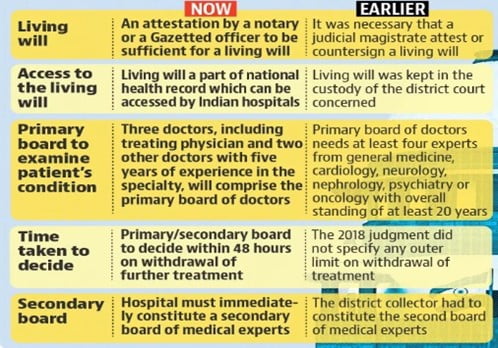Governance
Context: The Supreme Court has relaxed the guidelines for ‘advance medical directive’ that it issued in its 2018 judgment by which it had legalised passive euthanasia under certain circumstances. There is a long legal history to the matter.
About Euthanasia:
- Greek words: The term Euthanasia comes from two Ancient Greek words: ‘Eu’ means ‘Good’, and ‘thantos’ means ‘death’, so Euthanasia means good death.
- Euthanasia can be also divided into two types according to means of death.
- Active Euthanasia: It is also known as ‘Positive Euthanasia’ or ‘Aggressive Euthanasia’.
- It refers to causing intentional death of a human being by direct intervention.
- For example, by giving lethal doses of a drug or by giving a lethal injection.
- Active euthanasia is usually a quicker means of causing death and all forms of active euthanasia are illegal.
- Passive Euthanasia: It is also known as ‘Negative Euthanasia’ or ‘Non-Aggressive Euthanasia’.
- It is intentionally causing death by not providing essential, necessary and ordinary care or food and water.
- It implies discontinuing, withdrawing or removing artificial life support systems.
- Passive euthanasia is usually slower and more uncomfortable than active.
- Most forms of voluntary, passive and some instances of non-voluntary, passive euthanasia are legal.
New guidelines:

- Living will:
- 2018 guideline: It will be in the custody of the district court concerned.
- New guideline: It will be a part of the national health digital record which can be accessed by hospitals and doctors from any part of the country.
- Primary board:
- 2018 guideline: The primary board should comprise at least four experts from the fields of general medicine, cardiology, neurology, nephrology, psychiatry or oncology — with overall standing in the profession for at least 20 years.
- New guideline: Team of three doctors, including the treating physician and two other doctors with five years of experience in the concerned specialty will comprise the primary board.
- Time limit for Primary board:
- 2018 guideline: No time limit specified.
- New guideline: Board will preferably decide within 48 hours on the withdrawal of further treatment.
- Secondary medical board:
- 2018 guideline: The district collector concerned had to constitute the second board of medical experts.
- New guideline: If the primary medical board certifies that the treatment should be withdrawn in terms of the instructions contained in the living will, the hospital shall immediately constitute a secondary medical board.
- It comprising of a doctor nominated by the chief medical officer of the district concerned and two subject experts of the relevant specialty with minimum five years’ standing who were not part of the primary board.
- Time limit for Secondary medical board:
- 2018 guideline: There was no timeline specified secondary medical board in the 2018 judgment
- New guideline: Board will also decide preferably within 48 hours. They may also need to reflect on the conditions or consult others.
Source: Indian Express
Previous Year Question
Q.1) What is the importance of using Pneumococcal Conjugate Vaccines in India? (2020)
- These vaccines are effective against pneumonia as well as meningitis and sepsis.
- Dependence on antibiotics that are not effective against drug-resistant bacteria can be reduced.
- These vaccines have no side effects and cause no allergic reactions.
Select the correct answer using the code given below :
- 1 only
- 1 and 2 only
- 3 only
- 1, 2 and 3











